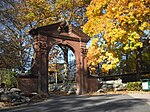Houvenkopf Mountain
Mahwah, New JerseyMountains of Bergen County, New JerseyMountains of New JerseyRamapos
Houvenkopf or Hovenkopf Mountain is a mountain in Bergen County, New Jersey. It extends into New York, where it forms the western side of the southern entrance to Ramapo Pass. The major peak on the New Jersey side rises to 931 feet (284 m) and is known as Stag Hill. It is separated by a deep saddle from the major peak on the New York side known as the Hooge Kop proper, which rises to about 770 feet (230 m). Houvenkopf Mountain is located in Mahwah, New Jersey and overlooks Hillburn to the north, Suffern to the east, and Ringwood, New Jersey to the west. It is part of the Ramapo Mountains.
Excerpt from the Wikipedia article Houvenkopf Mountain (License: CC BY-SA 3.0, Authors).Houvenkopf Mountain
Kapellenberg, Wittighausen
Geographical coordinates (GPS) Address Nearby Places Show on map
Geographical coordinates (GPS)
| Latitude | Longitude |
|---|---|
| N 41.1059292 ° | E -74.1751453 ° |
Address
St.-Sigismund-Kapelle
Kapellenberg
97957 Wittighausen
Baden-Württemberg, Deutschland
Open on Google Maps







